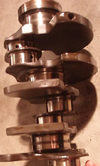Formula One crankshafts after 2014
 The provisional rules for the 2014 Formula One World Championship engines are now available to view on the FIA website. The change from the current 18,000 rpm 2.4 litre V8s to the 2014 1.6 litre V6 turbocharged engines was not straightforward, and came after a considerable period during which the engine suppliers were working towards supplying four-cylinder engines for 2013.
The provisional rules for the 2014 Formula One World Championship engines are now available to view on the FIA website. The change from the current 18,000 rpm 2.4 litre V8s to the 2014 1.6 litre V6 turbocharged engines was not straightforward, and came after a considerable period during which the engine suppliers were working towards supplying four-cylinder engines for 2013.
There are some important changes and restrictions affecting the design of crankshafts for 2014, which go beyond the obvious requirement to deal with two fewer con rods.
There is a requirement to have crankshafts with only three crankpins; there is no option to have either a six-pin crankshaft or one with 'split' or offset pins. Both offset pin cranks and six-pin cranks are commonly found on production six-cylinder engines, particularly ones whose bank angles are 90º (as is the mandated bank angle for the 2014 Formula One engines). The main benefit of this rule would seem to be the prevention of effort and money being expended on investigating alternative crankpin arrangements.
There are two other new crankshaft regulations that would appear to be linked. These are that the crankshaft height is mandated at 90 mm from the bottom of the engine, and that no material with a density greater than 9000 kg per cubic metre can be assembled to the crankshaft.
In the past, much effort was put into the design of Formula One engines that had the lowest possible crankshaft axis height above the bottom of the engine. Not only could the engine thus be positioned lower in the car, but the gearbox input axis was also positioned low down. With an increased stroke and much higher cylinder pressures in the new turbocharged engines, Formula One engine designers would need to increase crankshaft axis height, but with the new rules, they no longer need to design to a minimum.

Combined with mandated fixing locations between the engine and gearbox, this allows engines to be swapped season-to-season, giving privateer teams more opportunity to use the most competitive engines. Quite what this does for independent engine suppliers isn't clear, but it probably doesn't encourage them into the sport/business.
Given an easily achieved crankshaft axis height, there is less incentive to use tungsten counterweighting. However, in the search for minimum crankshaft inertia, people would undoubtedly turn to tungsten crankshaft counterweights, as is the case in other, lower-budget series and even some high-end roadcars. As a method of producing a low-inertia crankshaft, tungsten is very effective. Its removal from the rules doesn't stop people working toward low inertia; it simply means the crankshafts inside these engines will be increasingly intricately machined.
Any gears in the timing drive from the crankshaft to the camshafts must be a minimum of 8 mm wide, having previously not been subject to any restriction, and this logically means that the gear on the crankshaft is also a minimum of 8 mm wide.
The rule prohibiting welding between the front and rear main bearings remains, making the use of the 'hollow crankshaft' unlikely in the near future, although novel manufacturing technologies may allow hollow crankshafts without breaking this particular rule.
Fig. 1 - The option of running a 'split-pin' crank, as per this example from a Honda NSX, isn't an option for the 2014 Formula One engines
Written by Wayne Ward